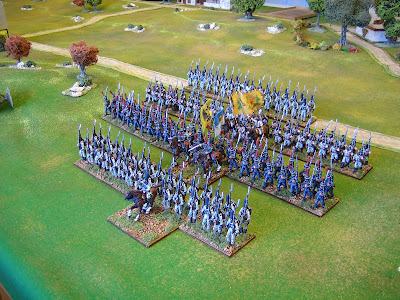Some time ago I finished a commission of 40mm figures for a client in New York, a client who does not do things by half.
In the past my client has told me that some of the 40mm stuff he gets back through the post, mostly from Europe, arrives damaged in transit.
This is for two reasons. Firstly, 40mm figures are heavy with thin parts (muskets etc.) and can be easily bent or broken if they get shaken in the package, much more so than 28mm. Secondly, this client likes his stuff based on multi figure stands which means they can't be held flat between soft shock absorbing packaging. They need more, much more.
I've painted a lot of this stuff for this client over the years and over that time I've developed a packaging technique to cope with the weight and fragility of multiply based 40mm figures. You might think this packaging method is a lot of work. However, the contents of this parcel were worth an awful lot of money and they needed to get to their destination safely to prevent greater costs and my professional blushes.
First, each stand needs to be self enclosed so that even if the figures get bounced around they are self protecting.
To this end I use thin card sleeves (old greetings cards), placed over the end files of figures so that any vertical pressures don't actually come down on the figures themselves - the pressure comes down on the top of the sleeve and the base.
These sleeves are all cut to the same height so that they will fit snuggly into the package's compartments (see below).
These sleeves are held in place by a wrap around of bubble wrap.
Each stand is then placed into a box divided into made to measure compartments. These compartments are made with corrugated card glued together with PVA. They are just a tiny bit longer and wider than the figures' bases and as deep as the height of sleeve, base thickness and bubble wrap.
When the figures' base is wedged into a compartment there isn't any horizontal pressure on the figures. The stand can't tip because when a lid is put on top of the compartment the vertical pressure on the sleeve holds the base flat on the bottom of the box. Any pressure caused by horizontal movement against the sides of the compartment is taken on the edges of the base.
Each compartment is only as deep as the figures plus sleeve, plus a few millimetres for one or two layers of bubble wrap - this is very important, if the figures require too much padding at the top the lid will not hold the sleeve down firmly enough.
This box has two different heights of compartment. One for 'rank and file' stands, one for 'command' stands. It also has some spare room at one end, compartmentalised purely for strength.
Some stands, like this one, have figures that overlap each other (see the mounted officer's outstretched arm) and require the card sleeves to be slotted so that the sleeves don't squash any of the figures with sideways pressure.
The trick is for the bottom of the sleeve (less slots) to wholly rest on the base.
You can probably just see the slit cut in the right hand sleeve (the officers arm is poking through it) to allow the card to slot over the figures cleanly.
The height of standards also require additional packaging bits.
To stop tall sleeves being bent inwards onto standards and the like, some sleeves need to have card spacers placed between them - everything is simply held together with bits of tape.
Once the figures are in the compartments, the compartments need to be sealed with an internal lid before the whole is sealed with the outer box lid. (Unless the box is the same depth as the compartments, which hasn't ever been the case in my experience).
Once sealed I usually wrap the whole thing with brown paper and packing tape.
For packages to the US it's as cheap to use a courier as anything else. I think the post on this parcel was about £75.
You'll be pleased to hear that, according to my client, these figures arrived in Manhattan "without a so much as a bent musket."
I would like to thank CG for permission to photograph his commission for the purpose of this post. Safely packing 40mm for postage isn't as easy as packing 28mm, not by a long shot.
















.JPG)

.JPG)

.JPG)

.JPG)







